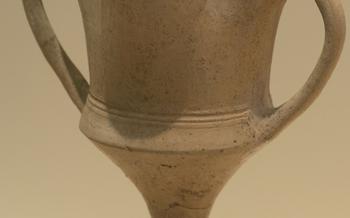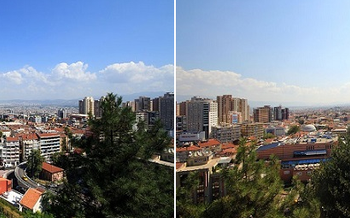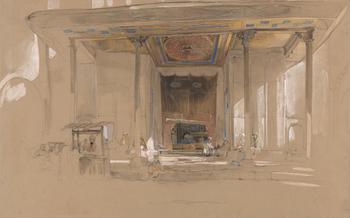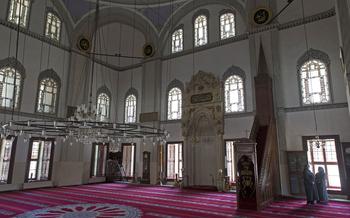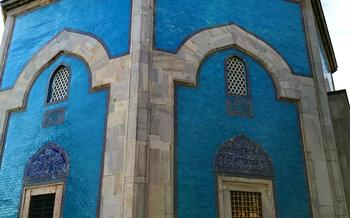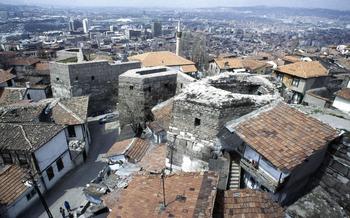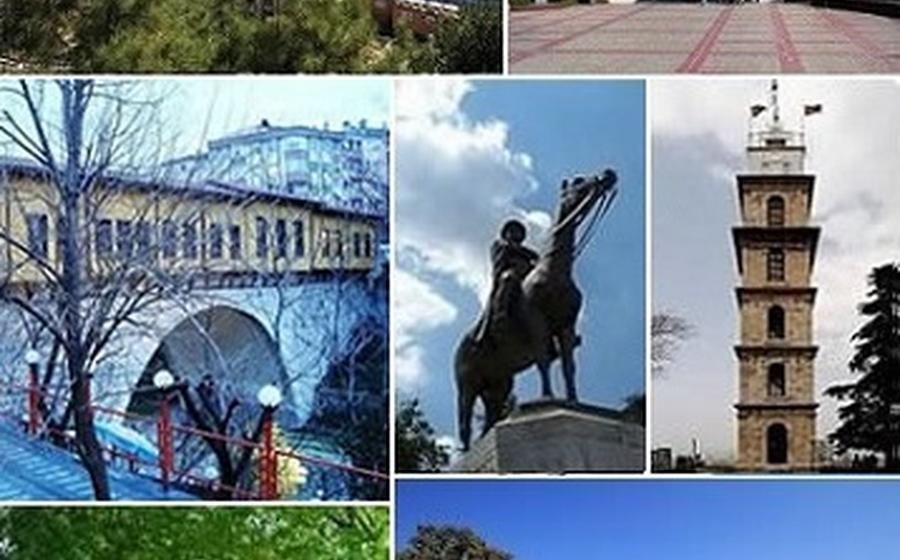
Bursa City Square (Kent Meydanı)
- Bursa City Square (Kent Meydanı)
- Clock Tower
- Orhan Gazi Mosque
- Covered Bazaar (Kapalı Çarşı)
- Grand Mosque of Bursa (Ulu Cami)
- Green Mosque (Yeşil Cami)
- Bursa Silk Market
- Emir Sultan Mosque
- Mount Uludağ (Uludağ)
- Bursa Museum of Archaeology
- Bursa Atatürk Museum
- Bursa Botanical Park (Botanik Park)
- Iskender Kebab
- Turkish Delight (Lokum)
- Insider Tip
Bursa City Square (Kent Meydanı)
Bursa Citys historic city center. It is a bustling public square that has been a focal point of the city's social, cultural, and commercial life for centuries.
The square's history dates back to the Ottoman period when it was used as a market and gathering place. Over the years, it has undergone several transformations, but it has retained its significance as a central meeting point for locals and visitors alike.
Located in the heart of the city, the square is easily accessible on foot or by public transportation. It is surrounded by a number of important landmarks, including the Grand Mosque of Bursa, the Covered Bazaar, and the Clock Tower.
Clock Tower
The Clock Tower, an iconic landmark of Bursa City Square, stands as a testament to the city's rich history and cultural heritage. Erected in the early 1900s during the reign of Sultan Abdul Hamid II, the tower was meticulously designed and constructed to serve as a symbol of the Ottoman Empire's grandeur.
Soaring high above the square, the Clock Tower boasts an impressive architectural design that blends traditional Ottoman elements with European influences. Its intricate stonework, detailed carvings, and elegant clock face reflect the artistic prowess of the era. The tower's strategic location at the heart of the city ensures that its melodious chimes resonate throughout the square, marking the passage of time and adding to the vibrant atmosphere.
Beyond its practical function of keeping time, the Clock Tower holds significant cultural importance for the people of Bursa. It serves as a gathering point for locals and tourists alike, who come together to admire its beauty, capture memorable photographs, and soak in the historical ambiance of the city square. The tower has become an integral part of Bursa's identity, symbolizing the city's rich past and its vibrant present.
Orhan Gazi Mosque
The Orhan Gazi Mosque, named after the founder of the Ottoman Empire, Orhan Gazi, stands as a testament to the rich architectural legacy of Bursa. Built in the 14th century, the mosque showcases a fusion of Seljuk and Ottoman architectural styles, reflecting the transition between the two empires.
Architectural Style
The Orhan Gazi Mosque exhibits a rectangular footprint, a common feature in early Ottoman mosques. Its imposing facade is adorned with intricate stone carvings, showcasing motifs and patterns inspired by Seljuk and Byzantine influences. The main entrance, known as the pishtaq, is framed by a pointed arch, further emphasizing the Seljuk architectural heritage.
Historical Significance
The construction of the Orhan Gazi Mosque marked a significant milestone in the history of Bursa and the Ottoman Empire. It served as the city's main mosque during the early years of Ottoman rule and played a crucial role in the development of Ottoman architectural traditions. The mosque's historical significance is further enhanced by its association with Orhan Gazi, a revered figure in Turkish history.
Interior Design and Features
The interior of the Orhan Gazi Mosque exudes a sense of simplicity and elegance. The prayer hall is spacious and airy, with rows of columns supporting the vaulted ceiling. The mihrab, indicating the direction of Mecca, is intricately carved and adorned with colorful tiles, adding a touch of vibrancy to the minimalist interior. The mosque also features a minaret, a slender tower from which the call to prayer is recited, contributing to the overall architectural composition.
Covered Bazaar (Kapalı Çarşı)
The Covered Bazaar, also known as the Kapalı Çarşı, ranks among the oldest and most captivating bazaars in Turkey. Its history traces back to the Ottoman era, when it served as a vibrant trading hub. Over the centuries, the bazaar has preserved its traditional charm while adapting to modern times. It has become an iconic landmark of Bursa and a must-visit attraction for both locals and tourists.
Located in the heart of the city center, the Covered Bazaar is easily accessible on foot or by public transportation. Its strategic position along trade routes made it a significant commercial center in the past. Today, it continues to thrive as a bustling marketplace, offering a diverse range of goods and services.
The unique architecture of the Covered Bazaar is a testament to its historical significance. Its vaulted ceilings, intricate arches, and cobblestone alleys create a captivating ambiance. The bazaar comprises numerous shops and stalls, each specializing in a variety of products, from traditional textiles and handicrafts to jewelry, spices, and souvenirs.
One of the highlights of the Covered Bazaar is its vibrant atmosphere. The air is filled with the sounds of bargaining, the scent of spices, and the hum of daily life. Visitors can engage with friendly shopkeepers, learn about local customs, and discover hidden treasures among the stalls.
The Covered Bazaar is an ideal place to experience the authentic charm of Bursa and immerse oneself in the richness of Turkish culture. It is an excellent spot to find unique souvenirs, indulge in traditional Turkish delights, and savor the flavors of local cuisine.
Grand Mosque of Bursa (Ulu Cami)
The Grand Mosque of Bursa, also known as Ulu Cami, stands as a testament to the city's rich history and architectural prowess. Built during the reign of Sultan Bayezid I between 1399 and 1400, this magnificent mosque is considered one of the finest examples of early Ottoman architecture.
Architectural Features:
- Imposing Structure: The mosque's grand entrance, adorned with intricate carvings and inscriptions, sets the tone for the awe-inspiring experience that awaits within.
- Twenty Domes: Its most striking feature is the cascade of twenty domes that grace the roof, creating a harmonious rhythm and a sense of grandeur.
- Marble Columns: The interior is supported by a forest of elegant marble columns, each one a testament to the skilled craftsmanship of the era.
- Calligraphy and Iznik Tiles: The walls are adorned with exquisite calligraphy and vibrant Iznik tiles, adding a touch of color and artistry to the sacred space.
Historical Significance:
- Symbol of Ottoman Power: Ulu Cami stands as a symbol of the growing power and influence of the Ottoman Empire, showcasing their architectural prowess and commitment to religious devotion.
- UNESCO World Heritage Site: In recognition of its exceptional universal value, the mosque has been inscribed as a UNESCO World Heritage Site, further solidifying its importance on the global stage.
Religious and Cultural Importance:
- Center of Worship: As the city's principal mosque, Ulu Cami serves as a central place of worship for the Muslim community, attracting worshippers from all corners of Bursa.
- Cultural Landmark: Beyond its religious significance, the mosque is a cultural landmark that embodies the rich heritage and traditions of Bursa, drawing visitors from around the world to marvel at its beauty and historical significance.
Green Mosque (Yeşil Cami)
The Green Mosque, also known as Yeşil Camii, is a stunning example of Ottoman architecture and a prominent landmark in Bursa. Constructed between 1419 and 1424 during the reign of Sultan Mehmed I, the mosque is renowned for its exquisite tilework and intricate decorations.
The Green Mosque's architectural design is a blend of Seljuk and Ottoman styles, featuring a central dome, four minarets, and an elegant courtyard. The mosque's interior is adorned with vibrant Iznik tiles, which depict intricate floral patterns, geometric designs, and calligraphy. The tiles, which are predominantly green, give the mosque its distinctive name.
The Green Mosque holds significant historical and cultural importance. It was commissioned by Sultan Mehmed I to commemorate his victory over the Byzantines at the Battle of Ankara in 140The mosque served as a religious and cultural center during the Ottoman period and continues to be a popular tourist attraction today.
Visitors to the Green Mosque are captivated by its stunning tilework, which covers the walls, mihrab (prayer niche), and minbar (pulpit). The intricate designs and vibrant colors create a mesmerizing visual experience, showcasing the artistry and craftsmanship of the Ottoman era.
The Green Mosque stands as a testament to the architectural prowess and cultural heritage of the Ottoman Empire. Its unique tilework and historical significance make it a must-visit destination for anyone exploring the rich history and beauty of Bursa.
Bursa Silk Market
Bursa, renowned for its rich silk-making heritage, boasts a vibrant Silk Market that has flourished for centuries. Immerse yourself in the bustling atmosphere of this traditional bazaar, where the air is alive with the hum of looms and the vibrant colors of silk threads.
The history of silk production in Bursa dates back to the Ottoman era when the city became a significant center for the textile industry. Bursa's favorable climate and skilled artisans contributed to the production of exquisite silk fabrics that gained worldwide recognition.
As you stroll through the narrow streets of the Silk Market, you'll be captivated by the array of silk products on display. From shimmering bolts of fabric to intricately embroidered scarves, the market offers a treasure trove of unique and authentic items.
Don't miss the opportunity to witness the artisans at work, demonstrating their mastery as they weave intricate patterns and create beautiful designs. The market is a testament to the enduring legacy of Bursa's silk-making tradition, where time-honored techniques are passed down from generation to generation.
Immerse yourself in the vibrant culture of Bursa by haggling for the best prices and engaging with the friendly vendors who are always willing to share their knowledge and stories about the art of silk-making. Whether you're a seasoned shopper or simply looking for a unique souvenir, the Bursa Silk Market promises an unforgettable experience.
Emir Sultan Mosque
The Emir Sultan Mosque, a captivating architectural masterpiece, stands as a testament to the rich cultural heritage of Bursa. Its construction, dating back to the 15th century, reflects the vision of the renowned architect Hacı İvaz Pasha, who meticulously crafted this sacred space to honor the revered Sufi mystic Emir Sultan.
With its graceful minarets piercing the skyline, the Emir Sultan Mosque exudes an air of serenity and spirituality. Its exterior, adorned with intricate tilework and decorative elements, hints at the exquisite beauty that awaits within.
Upon entering the mosque, visitors are greeted by a harmonious blend of architectural styles. The Seljuk and Ottoman influences are seamlessly intertwined, creating a mesmerizing visual tapestry. The central dome, supported by elegant columns, casts a soft, ethereal glow onto the elaborate interior.
The highlight of the mosque lies in its magnificent mihrab, a prayer niche that serves as the focal point of the qibla wall. Intricately carved and adorned with colorful tiles, the mihrab becomes a mesmerizing work of art, captivating the hearts and minds of all who behold it.
The Emir Sultan Mosque also houses the mausoleum of its namesake, Emir Sultan, a revered figure in Sufi mysticism. Pilgrims and visitors alike come to pay their respects and seek blessings at the tomb of this beloved saint.
A visit to the Emir Sultan Mosque offers a glimpse into the spiritual and cultural essence of Bursa. Its exquisite architecture, serene ambiance, and historical significance make it a must-see destination for travelers seeking a deeper understanding of Turkey's rich heritage.
Mount Uludağ (Uludağ)
Natural beauty and landscapes Mount Uludağ, also known as Uludağ, is a stunning natural wonder located near Bursa. Its lush forests, cascading waterfalls, and breathtaking panoramic views make it a popular destination for nature enthusiasts and outdoor adventurers. Visitors can immerse themselves in the beauty of the mountain's diverse landscapes, from lush green valleys to snow-capped peaks, offering a unique and unforgettable experience.
Hiking trails and outdoor activities Mount Uludağ offers a variety of hiking trails for visitors of all skill levels. These trails wind through dense forests, alongside sparkling streams, and up to the summit, providing hikers with stunning views and a chance to explore the mountain's rich flora and fauna. The mountain is also a popular destination for camping, picnicking, and mountain biking, offering visitors a chance to fully immerse themselves in the natural beauty of the region.
Skiing and winter sports During the winter months, Mount Uludağ transforms into a winter wonderland, attracting skiers and snowboarders from around the world. The mountain's well-maintained slopes and modern ski facilities make it an ideal destination for winter sports enthusiasts. Visitors can enjoy thrilling runs down the slopes, surrounded by stunning mountain scenery, and take advantage of the ski schools and rental shops to improve their skills or try out the sport for the first time.
Bursa Museum of Archaeology
Bursa Museum of Archaeology proudly stands as a guardian of the city's rich past, housing an impressive collection of artifacts that narrate the story of ancient civilizations that once flourished in this region. Its exhibits take visitors on a journey through time, showcasing the vestiges of bygone eras and shedding light on the cultural heritage that Bursa proudly embraces.
The museum's collection boasts an array of archaeological treasures, including intricate pottery, finely crafted jewelry, and sculptures that reveal the artistry and technical prowess of ancient craftsmen. Each artifact tells a tale of the region's past, providing glimpses into the lives, beliefs, and customs of the people who inhabited this land centuries ago.
One of the highlights of the museum is the collection of artifacts from the Phrygian civilization, an ancient kingdom that ruled over much of Anatolia in the 8th century BC. These artifacts, including beautifully preserved bronze figurines, ceramics, and inscriptions, offer valuable insights into the culture and daily life of the Phrygians.
The museum also houses a remarkable collection of artifacts from the Hellenistic period, a time of cultural exchange and interaction between Greek and Eastern civilizations. Among these artifacts are exquisite marble sculptures, intricate mosaics, and coins bearing the images of Alexander the Great and his successors.
Visitors to the Bursa Museum of Archaeology will find themselves immersed in the region's rich history, surrounded by relics that evoke the spirit of ancient civilizations. The museum serves as a testament to the enduring legacy of Bursa, a city that has witnessed the rise and fall of empires and continues to cherish the treasures of its past.
Bursa Atatürk Museum
The Bursa Atatürk Museum is a testament to the life and legacy of Mustafa Kemal Atatürk, the founding father of the Turkish Republic. Located in the heart of Bursa, this museum offers a glimpse into the history and accomplishments of one of the most influential figures in modern Turkish history.
Historical Significance
Atatürk played a pivotal role in the Turkish War of Independence, leading the Turkish forces to victory and establishing the Republic of Turkey in 192The museum houses artifacts, documents, and personal belongings that shed light on Atatürk's life, his vision for Turkey, and his contributions to the nation's development.
Exhibits and Collections
The museum's exhibits include photographs, manuscripts, uniforms, and other personal items that belonged to Atatürk. Visitors can learn about his childhood, his military career, his political achievements, and his tireless efforts to modernize and transform Turkey into a secular and progressive nation.
Educational and Cultural Value
The Bursa Atatürk Museum is not only a place of historical significance but also an educational and cultural institution. It serves as a reminder of the importance of Atatürk's leadership and his enduring legacy in shaping the course of Turkish history. The museum offers guided tours, educational programs, and workshops to promote a deeper understanding of Atatürk's life and his contributions to Turkey's development.
Bursa Botanical Park (Botanik Park)
Explore the Green Oasis of Bursa: Bursa Botanical Park
Amidst the bustling city of Bursa, nestled between the foothills of Mount Uludağ and the vibrant urban landscape, lies a tranquil haven known as the Bursa Botanical Park. This verdant paradise is a testament to nature's beauty and diversity, inviting visitors to immerse themselves in a world of exotic flora and serene landscapes.
With its inception in 1990, the Bursa Botanical Park was established as a sanctuary for plant conservation, scientific research, and recreational activities. Spanning over 400 acres, the park boasts a breathtaking collection of over 10,000 plant species, representing diverse ecosystems from around the world.
Strolling through the park's meticulously designed gardens, visitors are greeted by a symphony of colors and textures. From the delicate petals of roses to the towering majesty of ancient trees, each plant tells a unique story of adaptation and resilience. The park's collection includes rare and endangered species, as well as a rich variety of native Turkish flora.
Beyond its botanical significance, the Bursa Botanical Park is also a haven for outdoor enthusiasts and nature lovers. Winding paths invite visitors to explore the park's hidden corners, while serene ponds and cascading waterfalls create a tranquil ambiance. Visitors can relax and rejuvenate in designated picnic areas, or embark on educational guided tours that delve into the fascinating world of plant life.
The park also hosts a variety of events and workshops throughout the year, ranging from gardening classes to birdwatching sessions. These events provide an opportunity for visitors to connect with nature, learn about sustainable practices, and appreciate the intricate web of life that sustains our planet.
Whether you're seeking a peaceful retreat from the city's hustle and bustle, or an opportunity to immerse yourself in the wonders of the natural world, the Bursa Botanical Park offers an unforgettable experience for visitors of all ages.
Iskender Kebab
Iskender kebab, a culinary masterpiece named after its creator, İskender Efendi, ranks among the most iconic dishes of Bursa and Turkey. Its origins can be traced back to the late 19th century when İskender Efendi, a skilled chef and restaurateur, revolutionized the traditional kebab by introducing a unique preparation and presentation style that would forever change the culinary landscape of Bursa.
The Iskender kebab's journey begins with thin slices of döner, a seasoned and roasted lamb or beef meat, carefully placed atop crispy, golden-fried pita bread. This culinary masterpiece is then generously smothered in a rich tomato sauce, a secret family recipe passed down through generations, creating a harmonious blend of flavors that tantalizes the taste buds.
To complete this culinary symphony, a generous dollop of melted butter is poured over the kebab, infusing it with an irresistible aroma and a velvety texture that melts in your mouth. A sprinkling of fresh parsley and a drizzle of tangy yogurt add the finishing touches, creating a kaleidoscope of flavors and textures that will leave you craving for more.
Iskender kebab is more than just a dish; it's a symbol of Bursa's culinary heritage and a testament to the ingenuity and passion of its people. Savor this delectable creation in one of the many traditional restaurants in Bursa, where the air is filled with the sizzle of döner and the tantalizing aroma of spices, transporting you to a culinary heaven where taste buds rejoice.
Turkish Delight (Lokum)
Turkish delight, also known as lokum, is an iconic confectionery delicacy that has been cherished in Turkey for centuries. This sweet treat traces its roots back to the 15th century, when it was first crafted in the kitchens of the Ottoman Empire. Initially reserved for the sultan and his court, lokum eventually gained widespread popularity and became a beloved treat enjoyed by people from all walks of life.
Turkish delight is distinguished by its unique flavor profile and texture. It is made from a blend of sugar, cornstarch, and water, which is cooked until it reaches a thick, jelly-like consistency. The mixture is then flavored with a variety of essences, including rosewater, lemon, and pistachio, and cut into small, bite-sized cubes. These cubes are often coated in powdered sugar or coconut, adding a touch of sweetness and texture.
The variety of flavors available in Turkish delight is astounding, catering to a wide range of preferences. From classic rosewater to exotic pomegranate and even savory options like walnut and hazelnut, there is a flavor to suit every palate. Each bite offers a burst of sweetness that melts in your mouth, leaving a lingering taste of delight.
Lokum holds a special place in Turkish culture and is often served as a gesture of hospitality or as a sweet treat to accompany coffee or tea. It is also a popular souvenir for tourists, who can find it in a variety of shapes, sizes, and flavors in shops and markets throughout the country. Whether you prefer the classic rose-flavored lokum or a more adventurous flavor combination, this delectable confection is a must-try for anyone visiting Turkey.
Insider Tip
Best time to visit Bursa: The best time to visit Bursa is during the shoulder seasons (April-May and September-October) when the weather is mild and pleasant. During these months, you can enjoy outdoor activities without the crowds and heat of the summer months.
Local customs and traditions: Bursa is a conservative city, so it's important to dress modestly and be respectful of local customs. When visiting religious sites, such as mosques, women should cover their heads and shoulders. It's also customary to remove your shoes before entering a mosque.
Practical tips for travelers: - Bursa is a walkable city, but you can also use the public transportation system to get around. The city has a modern tram system that connects the city center with the surrounding areas. - Bursa is a great place to shop for souvenirs and local crafts. You can find everything from traditional Turkish carpets and ceramics to modern clothing and accessories. - Be sure to try some of the local cuisine, such as İskender kebab and Turkish delight. Bursa is also known for its fresh fruits and vegetables, which you can find at the city's many markets.
